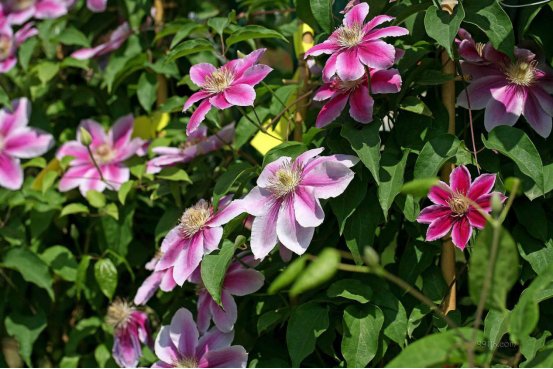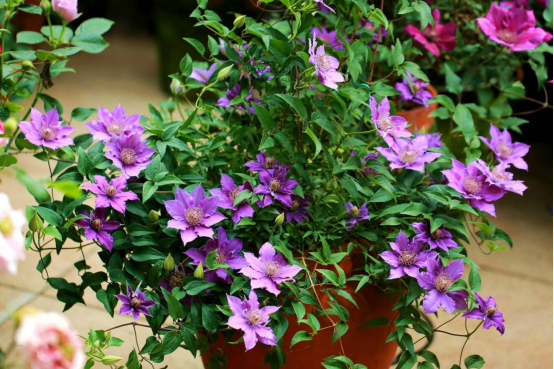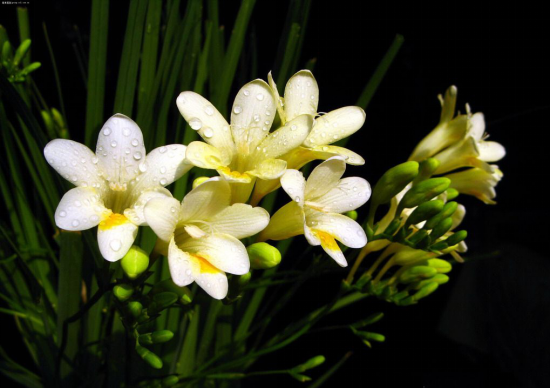Key points of clematis culture:
1. Soil:
Clematis like alkaline soil with fertile, loose and smooth drainage, and do not accumulate water and not be too dry.
2. Watering:
Clematis bogey is too wet, daily watering should pay attention to control watering, not too much, especially in the summer season with more Rain Water, watering should be reduced.
3. Sunshine:
Clematis can be planted in places with plenty of light throughout the year without shade, but it should be noted that the sun should not be exposed for a long time, which can easily lead to leaf yellowing.

Planting a pot of clematis at home can not only make the family full of vitality, but also has the role of purifying the air! Clematis has a strong ornamental, and the leaves are green, can be good-looking!
Main points of Clematis Transplantation methods of pruning Clematis
Clematis has a strong vitality and may need to be transplanted and pruned in the process of pot culture. Many friends do not know much about clematis transplant and pruning, and then Xiao Qi will share the main points of clematis transplantation and clematis pruning methods.
I. Clematis transplantation
1. Time of transplanting: potted clematis can be transplanted at any time of the year, because when transplanting clematis plants only need to be taken out of the pot and planted, without any damage to the roots of clematis. Of course, the ideal transplanting time for clematis is in spring or early autumn. During this period, the soil temperature is relatively warm, and the soil water content is more suitable, which can provide the best living environment for the plants that have just changed the environment. But as long as we can dig holes, we can plant clematis even in winter, even if it freezes soon, it won't be a big problem.
2, the steps of transplantation: there is no standard size for digging the pit, the size of the pit depends on the quality of the soil, if the soil is loose, fertile and well drained, it can be 30 cm or a shovel and a half deep, if on the contrary, the soil is thick and sticky, it is best to dig to the depth of 50-60cm, you can make a good drainage layer, as for the width, you need 30-40cm, so that the root can be put in freely.
2. The pruning method of clematis
The main results are as follows: 1. the flowering begins before the end of May, and the pedicel is short, usually bearing more than 2 flowers in the axils of the leaves. From February to March in the first year after planting, all branches should be cut short by 30 cm each. From February to March of the following year, all branches will be cut short by 1 meter each. After the third year, the weak branches and dead branches are cut off every year after flowering.
2. The flowers bloomed on the short branches germinated in the leaf axils of last year's branches, and each branch had one flower, and the flowering period began before the end of June. From February to March in the first year after planting, all branches should be cut short by 30 cm each. From February to March of the following year, all branches were cut short by I meters. After the third year, from February to March each year, all branches are cut short on the first pair of plump lateral buds.
3. The flowers bloom on the new branches of the same year, each branch has several flowers, and the flowering begins in July. From February to March in the first year after planting, leave all branches 30 cm short. After the second year, from February to March each year, all branches are cut above the base point of the previous year, and the height of the plant is not more than 75 centimeters above the surface.
These are the main points of clematis transplantation and clematis pruning methods. Friends who raise clematis at home can refer to them.
Matters needing attention in clematis cultivation
Clematis is a new flower in China in the past two years, which is deeply loved by people because of its various colors, variety and splendor. The attribute of Fujimoto makes it an indispensable new element in courtyard and balcony decoration. In fact, hundreds of years ago, the motherland already had a record of planting original varieties, which may not have been mainstream because of regional restrictions and a wide variety of flowers in the country. It was improved many times by foreign horticulturists, and it was not contacted by flower lovers until the network was increasingly developed. Clematis is a kind of plant that is very easy to grow. It is said that it is easy to grow because clematis can grow well without much care. Many flower friends have reported that clematis are difficult to grow and maintain. Here are some key points of my cultivation of clematis:
A well-drained substrate is the first step in raising clematis.
Clematis does not require high requirements for the matrix, we all use soilless matrix planting, the soil can also grow a very good effect, the premise is that the drainage of the matrix must be good, avoid clayey soil, some clayey soil must be improved, mix some tiles, tile basin fragments, perlite, foam particles to increase the drainage of the matrix is very important.
This is particularly important for the growth of clematis, clematis actually has a certain degree of drought tolerance, long-term substrate moisture will bring clematis a lot of potential diseases, in addition to the substrate when potted to add drainage layer at the bottom of the flowerpot is also very important, it is necessary to fill at least 5cm large-diameter ceramsite or brick tiles.
Clematis planting (experience)
Try to cultivate clematis with earthen pottery pots
Plastic pots are not recommended here. For flowers like clematis, which focus on their roots, a good root microenvironment often plays a decisive role in the performance of the whole plant. Clematis cultivated in earthen pots have several obvious advantages over plastic pots:
One is that the tile basin can make use of the micropores on its body surface to increase the excess water in the matrix. This is especially important for flower friends who have plum rain in summer in the south. It is important to know that earthen pots can help the matrix remove excess water as soon as possible.
Second, the water evaporation on the surface of the tile basin can be used to drive the dynamic balance of minerals in the matrix. You can keep the fertilizer in the substrate at a relatively low level (this is especially important for florists who like to use a lot of organic fertilizer and unrestricted fertilization, maybe earthen pots can keep your clematis away from fat damage).
The three-tile basin can use the water evaporation on its body surface to absorb the heat of the matrix and reduce the substrate temperature, which is very important for the southern flower friends who are very hot in summer. You should know that using the tile basin can effectively reduce the substrate temperature. Some heat-resistant clematis varieties can use this to increase the survival rate over the summer, because the pottery basins are relatively shallow. Try to choose slender pottery pots with a certain depth to facilitate the extension of clematis roots.
How to irrigate clematis correctly?
The irrigation management of clematis directly determines its root morphology. If you want to cultivate a robust root system, it is particularly important to maintain a good irrigation habit of "dry and wet". In fact, this clematis in my family is often irrigated when there is a shortage of water. That's why the root system is so strong, because I put clematis on the southern balcony, so that clematis can avoid the strongest sunshine at noon. Lack of water for a short time, clematis will not have any big problem, if your clematis are in rich sunshine conditions, and relatively open and ventilated position maintenance, or pay attention to do not let clematis lack of water too big, "dry see wet" is a very effective way to cultivate strong root flowers.
There are several points to pay attention to about fertilization.
In fact, clematis fertilization here is also very extensive, that is, the use of self-prepared water-soluble fertilizer, the formula is based on 13-2-13 based on the increase of some ammonium nitrogen and phosphorus, sulfur and other trace elements content, conservation so far, this self-prepared formula is still good, better than the general formula, the stem is very strong, the result of adequate supply of calcium. We have seen some flower friends use a large amount of organic fertilizer to cause fertilizer damage before. It is not recommended here that flower friends who have no experience in using organic fertilizer use a lot of organic fertilizer. It is suggested that we should start with low concentration water-soluble fertilizer and get familiar with the mechanism of plant absorbing nutrients.
- Prev

Clematis cuttage steps:
1. For the selection of branches, we should try to choose the relatively tender ones, which are not completely Lignified. Young shoots are easier to take root and sprout. 2. Cut the branches short and place them in vitamin B solution for two hours. After taking them out, apply some rooting powder slightly. 3. Insert the branches into the nursery box with perlite
- Next

Xiangxue orchid culture
Soil fragrant orchid is suitable for growing in loose sandy soil with strong water retention and good drainage. Before planting Xiangxue orchid, the soil should be irrigated and disinfected with the solution of pentachloronitrobenzene, methyl bromide and Yinglandan in proportion, and used after disinfection for a week. It is not only the soil that needs to be disinfected before planting.
Related
- Fuxing push coffee new agricultural production and marketing class: lack of small-scale processing plants
- Jujube rice field leisure farm deep ploughing Yilan for five years to create a space for organic food and play
- Nongyu Farm-A trial of organic papaya for brave women with advanced technology
- Four points for attention in the prevention and control of diseases and insect pests of edible fungi
- How to add nutrient solution to Edible Fungi
- Is there any good way to control edible fungus mites?
- Open Inoculation Technology of Edible Fungi
- Is there any clever way to use fertilizer for edible fungus in winter?
- What agents are used to kill the pathogens of edible fungi in the mushroom shed?
- Rapid drying of Edible Fungi

